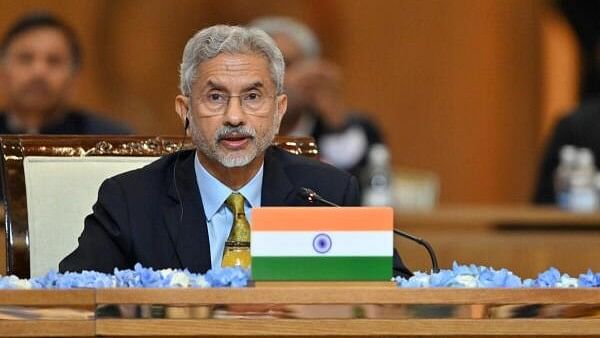
S Jaishankar
Credit: PTI Photo
New York: The patrolling arrangements between India and China along the Line of Actual Control (LAC) have been disturbed since the beginning of the military stand-off in eastern Ladakh in 2020 and the issue has not yet been resolved, External Affairs Minister S Jaishankar said in New York on Tuesday.
Jaishankar's comment on the unresolved issue of restoring the pre-2020 arrangements of patrolling by Indian and Chinese soldiers along the LAC came just a few days after the Lieutenant General of Ladakh, Brigadier (retd) B D Mishra, reiterated the claim of Prime Minister Narendra Modi’s government that no territory of India had been lost to China in recent years.
“When I said 75 per cent of it has been sorted out – I was asked in a way to quantify – it’s only of the disengagement,” the external affairs minister said at an event hosted by Asia Society and the Asia Society Policy Institute in New York.
He was responding to a query on a comment he had made at an event in Geneva on September 12. He had said that Indian and Chinese troops had mutually disengaged at 75 per cent of the friction points along the LAC in eastern Ladakh.
“So that's one part of the problem,” he said in New York. “The main issue right now is patrolling. You know, how do we, both of us, patrol up to the Line of Actual Control.”
Jaishankar said that the patrolling arrangements along the LAC had been disturbed after 2020. “So we've been able to sort out much of the disengagement, the friction points, but some of the patrolling issues need to be resolved.”
The aggressive moves by the Chinese PLA to unilaterally change the status quo along the LAC in eastern Ladakh and the counter-deployment by the Indian Army in April-May 2020 had started the military stand-off between the two neighbouring nations in eastern Ladakh.
A research paper presented by a police officer based at Leh in Ladakh at a conference of the top cops in New Delhi on January 22, 2023, had pointed out that India had lost access to 26 – PP 5-17, 24-32, 37, 51, 52 and 62 – of the 65 patrolling points along its LAC with China since 2020.
The bilateral relations hit a new low after the stand-off had reached a flashpoint with the violent clash between the soldiers of the Indian Army and the Chinese PLA in Galwan Valley on June 15, 2020.
The withdrawal of the Indian Army troops from the scene of the clash to reciprocate to the pull-back by the Chinese PLA as well as the moratorium on patrolling resulted in the creation of a three-kilometer-long (about 1.5 kilometres on both sides) “buffer zone” in Galwan Valley by July 6, 2020.
The Indian Army had earlier regularly sent soldiers from its permanent base at the Dhan Singh Thapa Post near Finger 3 on the northern bank of Pangong Tso lake for patrolling up to Finger 8. But it had to suspend patrolling after a scuffle between its troops and the Chinese PLA soldiers near Finger 4 in May 2020.
The PLA had later built bunkers and observation posts and deployed additional troops in the area – thus denying access to the Indian Army to its earlier patrolling limit at Finger 8. The February 2021 deal, however, created an eight-kilometer-long buffer zone between Finger 3 and Finger 8 on India’s side of the LAC with China (on Pangong Tso northern bank), with a moratorium on patrolling by both sides.
Though protracted negotiations led to the mutual withdrawal of troops by both the Indian Army and the Chinese PLA from Gogra Post and Hot Springs in 2022, the stand-off could not be resolved completely so far. The PLA troops deployed in Depsang, well inside the territory of India along the LAC with China, are continuing to block the Indian Army’s access to Patrolling Points 10, 11, 12, 12A, and 13. The two sides, however, recently reached closer to a deal for disengagement of troops from the face-off point at Demchok.
“I think the India-China relationship is key to the future of Asia. In a way, you can say that if the world is to be multi-polar, Asia has to be multi-polar. And, therefore, this relationship will influence not just the future of Asia, but in that way, perhaps the future of the world as well,” Jaishankar said in New York on Tuesday.
“You have two countries who are neighbours, unique in the sense that they are the only two countries with over a billion people, both rising in the global order and who often have overlapping peripheries, including the fact that they have a common border. So it's really a very complicated issue," he added.
"I think, if you look today in global politics, the parallel rises of India and China, present a very, very unique problem," he added.
